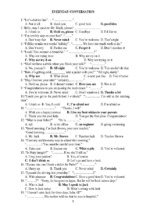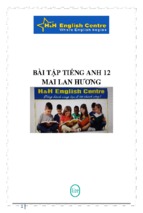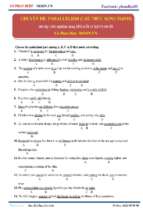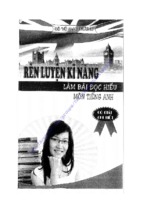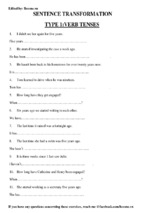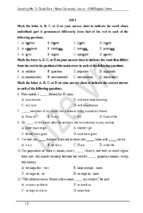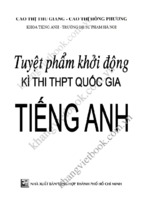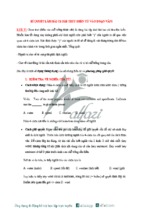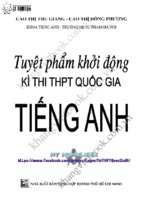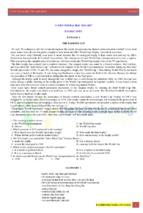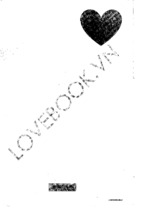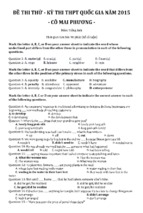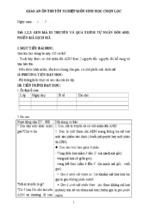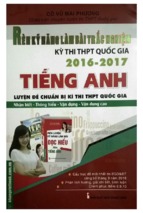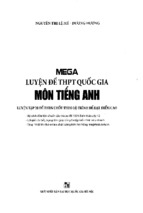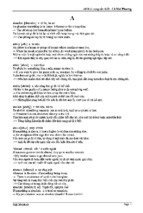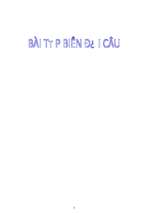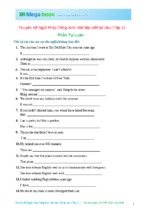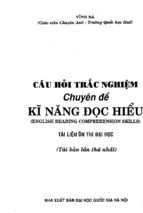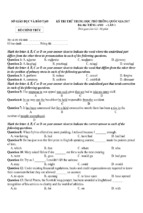ĐỀ SỐ 1
PHẦN TRẮC NGHIỆM: TỪ QUESTION 1 ĐẾN QUESTION 64 (8,0 điểm)
I. Mark the letter A, B, c, or D on your answer sheet to indicate the word whose underlined part is
pronounced differently from that of the rest in each of the following questions.
Question 1: A. experiencedB. workedC. watchedD. arrived
Question 2: A. whom
B. heal
C. healthy
D. honest
II. Mark the letter A, B, c, or D on your answer sheet to indicate the word or phrase that is CLOSEST
in meaning to the underlined part in each of the following questions.
Question 3:Before he went on vacation, Peter left explicit instructions for the decoration of his office.
A. clear
B. colorful
C. vague
D. direct
Question 4:Parents regard facial and vocal expressions as indicators of how a baby is feeling.
A. read
B. translate
C. display
D. consider
Question 5.In the 1980s, TV viewers began to hook up videocassette players to their TVs.
A. combine
B. stop
C. fasten
D. connect
III. Read the following passage and mark the letter A, B, C or D on your answer sheet to indicate the
correct answer to each of the following questions.
American humor and American popular heroes were born together. The first popular heroes of the
new nation were comic heroes, and the first popular humor of the new nation was the antics of its heroclowns.
The heroic and the comic were combined in novel American proportions in popular literature. The
heroic themes are obvious enough and not much different from those in the legends of other times
and places: Achilles, Beowulf, Siegfried, Roland, and King Arthur. The American Davy Crockett legends
repeat the familiar pattern of the old world heroic story: the pre-eminence of a mighty hero whose fame in
myth has a tenuous basis in fact; the remarkable birth and precocious strength of the hero; single combats in
which he distinguished himself against antagonists, both man and beast; vows and boasts; pride of the hero
in his weapons, his dog, and his woman.
Davy Crockett conquered man and beast with a swaggering nonchalance. He overcame animals by
force of body and will. He killed four wolves at the age of six. He hugged a bear to death; he killed a
rattlesnake with his teeth. He mastered the forces of nature. Crockett’s most famous natural exploit was
saving the earth on the coldest day in history. First, he climbed a mountain to determine the trouble. Then he
rescued all creation by squeezing bear-grease on the earth’s frozen axis and over the sun’s icy face. He
whistled, “Push along, keep moving!” The earth gave a grunt and began moving.
Neither the fearlessness nor the bold huntsman’s prowess was peculiarly American. Far more
distinctive was the comic quality, all heroes are heroic; few are also clowns. What made the American
popular hero heroic also made him comic. “May be”, said Crockett, “you’ll laugh at me and not at my
book”. The ambiguity of American life and the vagueness which laid the continent open to adventure, which
made the land a rich storehouse of the unexpected, which kept vocabulary ungoverned and the language
fluid----this same ambiguitysuffused both the Crockett legends were never quite certain whether to laugh or
to applaud, or whether what they saw and heard was wonderful, awful or ridiculous.
Question 6: What is the main point the author makes in the passage?
1
A. Davy Crockett wrote humorous stories about mastering the nature.
B. American popular heroes were characteristically comic.
C. The Davy Crockett stories reflected the adventurous spirit of early America.
D. American popular literature was based on the legends of other times and places.
Question 7: Achilles, Beowulf, and other heroes are mentioned in paragraph 2 to_________.
A. show their similar heroic nature with the American heroes.
B. show the role they play in the world legend history.
C. compare their popularity with that of the American heroes.
D. conclude heroic deeds described in old world heroic legends.
Question 8: Which of the following is NOT mentioned as a heroic theme?
A. Superior physical strength
B. Pride in the hero woman
C. Fluid use of language
D. Boasting by the hero
Question 9: The word “antagonists” could be best replaced by_________.
A. wild animals
B. heroes
C. forces
D. opponents
Question 10: Davy Crockett is an example of_________.
A. a popular writer
B. a heroic theme
C. an old world hero
D. a hero-clown
Question 11: In paragraph 3, the author mentions a story in which Davy Crockett_________.
A. killed a wild boar
B. saved a bear
C. saved the earthD. ate a rattlesnake
Question 12: The word “exploit” in paragraph 3 is closest meaning to_________.
A. resource
B. heroic act
C. skill
D. character trait
Question 13: The word “prowess” in paragraph 4 is closest meaning to_________.
A. goal
B. weapon
C. bravery
D. caution
: In paragraph 4, the author makes the point that_________.
A. Question 14American enjoyed laughing at other people.
B. American writers strove to create a distinctively American literature.
C. American life was open to adventure and full of the unexpected.
D. Americans valued comic qualities more than heroic qualities.
Question 15: The word “ambiguity” in the last paragraph is closest meaning to_________.
A. ridiculous
B. richness
C. uncertainty
D. quality
IV. Mark the letter A, B, C, or D on you answer sheet to indicate the word that differs from the rest in
2
the position of the main stress in each of the following questions.
Question 16: A. recommend B. fortunately
C. entertain
D. disappear
Question 17: A. apprehensive
C. emergency
D. resolution
C. impossible
D. beautiful
B. residential
Question 18: A. telephone
B. question
V. Mark the letter A, B, C, or D on your answer sheet to show the underlined part that needs
correction in each of the following questions.
Question 19: What I told hera few days ago werenot the solution tomost ofher problems.
A
B
C
D
Question 20:My mother preferscooking at home thaneatingout
A
B
C
D
Question 21.In the future, we willcertainly lead a more healthier life.
A
B
C
D
Question 22: The scholarship that Wilson received to study historyat Cambridge presented an unique
A
B
C
D
opportunity.
Question 23:We are working, thatmeans that weare contributinggoods andservicesto oursociety.
A
B
C
D
VI. Mark the letter A, B, C, or D on your answer sheet to indicate the correct answer to each of the
following questions.
Question 24:___________ Michelle tried hard, she didn’t manage to win the competition.
A. No matter how
B. Even though
C. In spite of
D. Nevertheless
Question 25:My phone is out of order, _________is a nuisance.
A. that
B. which
C. this
D. it
Question 26: Lan :“She seems_________for the job”. Hoa: “Yes. Everybody thinks she’s perfectly suited
for it.”
A. ready-made
B. home-made
C. tailor-made
D. self-made
Question 27:Mai and Lan are friends. Lan asks Mai about Mai’s plan. Select the most suitable response to
fill in the blank.
Lan: “Are you going to see the live show by Son Tung today?”
Mai: “_________”.
A. Yes, I enjoyed it very much
B. Maybe I’ll be out
C. Yes, I’m going to stay in
D. I think so
3
Question 28: I bitterly regret……………….him the story yesterday.
A. to be telling
B. telling
C. to tell
D. to have told
Question 29: The water company will have to……………….off water supplies while repairs to the
pipes are carried out.
A. cut
B. set
C. take
D. break
Question 30:There was ………………. to prevent the accident. It happened while everyone was
sleeping.
A. nothing we couldn't doB. anything we could do
C. nothing we could doD. something we could do
Question 31: Only when you grow up……………….how to organize things more neatly.
A. do you know
B. you will know
C. you know
D. will you know
Question 32. Her boss fired her, ____made her angry.
A. that
B. this
C. what
D. which
Question 33. You _____ the washing. My sister could have done it for you.
A. needn't have done
B. couldn't have done
C. hadn't to do
D. mustn't have done
Question 34. These school-leavers are looking forward ____ on campus.
A. living
B. to live
C. live
D. to living
Question 35. Would you like to take a gap year before ____ a university?
A. filling in
B. applying to
C. applying for
D. filling out
Question 36: One difference between mathematics and language is that mathematics is precise _________.
A. language is not
C. but language not
B. while language is not
D. while is not language
Question 37: Seldom _________ far enough north to disturb South Pacific shipping lanes.
A. Antarctic icebergs will move
B. will Antarctic icebergs move
C. will move Antarctic icebergs
D. move Antarctic icebergs will
Question 38: _________ the United States consists of many different immigrant groups, many sociologists
believe there is a distinct national character.
A. Even though B. Despite
C. Whether
D. In spite of
Question 39: The article analyzes the impact of the tax base _______ real estate prices and sales.
A. in
B. on
C. at
D. with
Question 40: .............................................., we went swimming.
A. Being a hot day
B. It was a hot day
C. Because the day was hot
D.As a hot day
Question 41: The United State turns out 16,5 billion hot dog each year. “Turns out” means
A. produces
B.controls
C.returns
D.delivers
Question 42: “All right, it’s true I was nervous”.
4
The leading actor......that he had been nervous.
A. apologized
B. confessed
C. agreed
D.thought
VII. Read the following passage and mark the letter A, B, C, or D on your answer sheet to indicate the
correct answer to each of the questions.
The concept of obtaining fresh water from iceberg that is towed to populated areas and arid regions of the
world was once treated as a joke more appropriate to cartoons than real life. But now it is being considered
quite seriously by many nations, especially since scientists have warned that the human race will outgrow its
fresh water supply faster than it runs out of food. Glaciers are a possible source of fresh water that has been
overlooked until recently. (A)
Three-quarters of the Earth's fresh water supply is still tied up in glacial ice, a reservoir of untapped
fresh water so immense that it could sustain all the rivers of the world for 1,000 years. Floating on the
oceans every year are 7,659 trillion metric tons of ice encased in 10,000 icebergs that break away from the
polar ice caps, more than ninety percent of them from Antarctica. (B)
Huge glaciers that stretch over the shallow continental shelf give birth to icebergs throughout the
year. Icebergs are not like sea ice, which is formed when the sea itself freezes; rather, they are formed
entirely on land, breaking off when glaciers spread over the sea. As they drift away from the polar region,
icebergs sometimes move mysteriously in a direction opposite to the wind, pulled by subsurface currents.
Because they melt more slowly than smaller pieces of ice, icebergs have been known to drift as far north as
35 degrees south of the equator in the Atlantic Ocean. (C)
The difficulty arises in other technical matters, such as the prevention of rapid melting in warmer
climates and the funneling of fresh water to shore in great volume. But even if the icebergs lost half of their
volume in towing, the water they could provide would be far cheaper than that produced by desalination, or
removing salt from water. (D)
Question 43: What is the main topic of the passage?
A. The movement of glaciers
B. Icebergs as a source of fresh water
C. Future water shortages
D. The future of the world's rivers
Question 44: The word "arid" in the first paragraph is closest in meaning to_______________.
A. anhydrous
B. fruitful
C. remote
D. distant
Question 45: The word "it" in the first paragraph refers to______________.
A. an iceberg that is towed
B. obtaining fresh water from icebergs
C. the population of arid areas
D. real life
Question 46: According to the author, most of the world's fresh water is to be found in________________.
A. oceans
B. rivers
C. glaciersD. reservoirs
Question 47: The word "currents" in the third paragraph is closest in meaning to
A. pulls
B. waves
Question 48: How are icebergs formed?
A. They break off from glaciers
C. Rivers freeze
C. weatherD. flows of water
B. Seawater freezes
D. Small pieces of floating ice converge
Question 49: With which of the following ideas would the author be likely to agree?
A. Towing icebergs to dry areas is economically possible
B. Desalination of water is the best way to obtain drinking water
C. Using water from icebergs is a very short-term solution to water shortages
D.Icebergs could not be towed very far before they would melt
Question 50: Which is the best place where the following sentence will most properly fit?
"To corral them and steer them to parts of the world where they are needed would not be too difficult."
A. (A)
B. (B)
C. (C)
D. (D)
Question 51: The word "that" in the last paragraph refers to________________.
5
A. the volume
B. the water
C. the iceberg
D. the towing
Question 52: What are the technical matters mentioned as the difficulty arising in the process of obtaining
fresh water from the iceberg?
A. The prevention of rapid melting iceberg
B. The filtering water and the funneling it to shore in a large amount
C. The purifying the fresh water and carrying it to shore
D. The prevention of rapid melting and the funneling to shore in great volume
VIII. Read the following passage and mark the letter A, B, C or D on your answer sheet to
indicate the best option for each of the blanks.
Education is more important today than ever before. It helps people acquire the skills they need for such
everyday (53)_______ as reading a newspaper or managing their money. It also gives them the specialized
training they may need to (54)_______ for a job or career. For example, a person must meet certain
educational requirements and obtain a (55)_______ or certificate before he can practice law or medicine.
Many fields, like computer operation or police work, (56)_______ satisfactory completion of special
training courses.
Education is also important (57)_______ it helps people get more out of life. It increases their knowledge
and understanding of the world. It helps them acquire the skills that make life more interesting and
enjoyable, (58)_______ the skills needed to participate in a sport, paint a picture, or play a musical
(59)_______ . Such education becomes (60)_______ important as people gain more and more leisure time.
Education also helps people adjust to change. This habit has become necessary because social changes today
take place with increasing speed and (61)_______ the lives of more and more people. Education can help a
person understand these changes and provide him (62)_______ the skills for adjusting to them.
Question 53.A. works
B. jobs
C. actions
D. activities
Question 54.A. do
B. prepare
C. make
D. work
Question 55.A. license
B. card
C. diploma
D. paper
Question 56.A. requires
B. requiring
C. require
D. to require
Question 57.A. therefore
B. despite
C. although
D. because
C. such that
D. for example
Question 58.A. such as
B. for instance
Question 59.A. appliance
B. equipment
C. instrument
D. device
Question 60.A. increased
B. increasing
C. increase
D. increasingly
Question 61.A. effect
B. affect
C. affective
D. effective
C. in
D. to
Question 62.A. with
B. for
IX. Mark the letter A, B, c, or D on your answer sheet to indicate the word or phrase that is
OPPOSITE in meaning to the underlined part in each of the following questions.
Question 63: Population growth rates varyamong regions and even among countries within the same
region.
A. remain unstable
B.fluctuate
C.restrain
D. stay unchanged
Question 64:I eat lunch with a convivial group of my friends.
A. unsociable
B. large
C. old
D. lively
II. Phần tự luận (2 điểm)
Part I. Finish each of the following sentences in such a way that it means the same as the
6
sentence given before it. (0,5 điểm)
1. There was a lot of noise, and I couldn’t hear her calling.
There was so __________________________________
2: He doesn’t have much money, so he can’t buy a luxury car.
If ___________________________________________
3.The book is so interesting that it has become the best-seller of this year.
It is __________________________________________
4: “I don’t know what you are talking about,” George said to me.
George said to me that___________________________
5: People say that Jenny lived in Texas, America for 8 years.
Jenny _______________________________________________
B. In 140 words, write a paragraph aboutyour free time activities
ĐÁP ÁN
CÂU HỎI
1
2
3
4
5
6
7
8
9
10
11
12
13
14
15
16
ĐÁP ÁN
D
D
A
D
D
B
C
C
D
D
C
B
C
C
C
B
CÂU HỎI
17
18
19
20
21
22
23
24
25
26
27
28
29
30
31
32
ĐÁP ÁN
C
B
B
C
C
D
A
B
B
C
D
B
A
C
D
D
CÂU HỎI
33
34
35
36
37
38
39
40
41
42
43
44
45
46
47
48
ĐÁP ÁN
A
D
B
B
B
A
B
C
A
B
B
A
B
C
D
A
CÂU HỎI
49
50
51
52
53
54
55
56
57
58
59
60
61
62
63
64
ĐÁP ÁN
A
C
B
D
D
B
A
C
D
A
C
D
B
A
D
A
LỜI GIẢI CHI TIẾT
I. Mark the letter A, B, c, or D on your answer sheet to indicate the word whose underlined part is
pronounced differently from that of the rest in each of the following questions.
Question 1: A. experienced
B. worked
C. watched
D. arrived
Đáp án D. arrived, phát âm là /d/, còn lại phát âm là /t/
A. Experienced /ɪkˈspɪriənst/ (adj) đã có kinh nghiệm
B. Worked /wɜːrkt/ (Vqk của work) làm việc
C. Watched /wɑːtʃt/ (Vqk của watch) xem
D. Arrived /əˈraɪvd/ (Vqk của arrive) đến
Với các từ có phiên âm kết thúc bằng /p, k, f, tʃ, dʒ, z, s, ʃ, θ/ thì khi thêm ‘ed’ ở dạng quá khứ, ta phát
âm là /t/
7
Với các từ có phiên âm kết thúc bằng /t,d / thì khi thêm ‘ed’ ở dạng quá khứ, ta phát âm là /ɪd/
Các trường hợp còn lại, ta phát âm là /d/
Question 2: A. whom
B. heal
C. healthy
D. honest
Đáp án D. honest, âm câm, còn lại phát âm là /h/
A. Whom /huːm/ (pronoun) dùng khi làm tân ngữ cho một hành động
B. Heal /hiːl/ (v) chữa lành
C. Healthy /ˈhelθi/ (adj) khỏe mạnh
D. Honest /ˈɑːnɪst/ (adj) thật thà
II. Mark the letter A, B, c, or D on your answer sheet to indicate the word or phrase that is CLOSEST
in meaning to the underlined part in each of the following questions.
Question 3:Before he went on vacation, Peter left explicit instructions for the decoration of his office.
A. clear
B. colorful
C. vague
D. direct
Đáp án A
Giải thích:
Explicit: (adj) rành mạch, dễ hiểu
A. Clear: rõ ràng
B. Colorful: sặc sỡ
C. Vague: mơ hồ
D. Direct: trực tiếp
Dịch nghĩa: Trước khi đi nghỉ, Peter để lại một bản hướng dẫn rất rành mạch về việc trang trí văn phòng.
Question 4:Parents regard facial and vocal expressions as indicators of how a baby is feeling.
A. read
B. translate
c. display
D. consider
Đáp án D
Giải thích:
Regard (v) coi là, xem như là
A. read (v) đọc
B. translate (v) dịch
C. display (v) trưng bày
D. consider (v) xem xét, coi là
Dịch nghĩa: Cha mẹ coi những biểu cảm trên khuôn mặt và âm thanh phát ra là biểu hiện cho biết đứa trẻ
cảm thấy thế nào.
Question 5.In the 1980s, TV viewers began to hook up videocassette players to their TVs.
A. combine
B. stop
C. fasten
D. connect
Đáp án D
Giải thích:
hook up: kết nối với thiết bị
A. combine: kết hợp
B. stop: dừng lại
C. fasten : thắt (dây an toàn trên ô tô)
D. connect: kết nối
Dịch nghĩa: Vào những năm 1980, người xem tivi bắt đầu kết nối đầu băng cát sét với tivi.
8
III. Read the following passage and mark the letter A, B, C or D on your answer sheet to indicate the
correct answer to each of the following questions.
Question 6: What is the main point the author makes in the passage?
A. Davy Crockett wrote humorous stories about mastering the nature.
B. American popular heroes were characteristically comic.
C. The Davy Crockett stories reflected the adventurous spirit of early America.
D. American popular literature was based on the legends of other times and places.
Dịch nghĩa: Tác giả muốn nói điều gì qua đoạn văn này?
A. Davy Crockett viết truyện cười về chinh phục thiên nhiên
B. Những nhân vật anh hùng của Mỹ là có nét đặc trưng là rất khôi hài
C. Truyện của Davy Crockett phản chiếu tinh thần thám hiểm của người Mỹ thời kì đầu
D. Văn học đai chúng Mỹ dựa vào truyền thuyết của những thời kì khác, những địa danh khác
Giải thích: Ngay đoạn đầu, tác giả đã nói về nội dung chính của bài viết “American humor and American
popular heroes were born together”. Các đoạn sau tiếp tục trình bày kĩ hơn chủ đề này: giới thiệu sơ qua về
câu chuyện của Davy Crockket (đoạn 2), tính anh hùng (đoạn 3), tính hài hước (đoạn 4).
Question 7: Achilles, Beowulf, and other heroes are mentioned in paragraph 2 to_________.
A. show their similar heroic nature with the American heroes.
B. show the role they play in the world legend history.
C. compare their popularity with that of the American heroes.
D. conclude heroic deeds described in old world heroic legends.
Dịch nghĩa: Achilles, Beowulf, và những anh hùng khác được nhắc đến ở đoạn 2 là để _________.
A. thể hiện bản chất anh hùng của họ giống với những anh hùng Mỹ
B. thể hiện vai trò của họ trong những truyền thuyết lịch sử thế giới.
C. so sánh sự phổ biến của họ với sự phổ biến của những anh hùng Mỹ
D. kết luận những chiến công anh hùng được miêu tả trong những truyền thuyết anh hùng thế giới cổ đại.
Giải thích: Thông tin nằm ở đoạn 2 “The heroic and the comic were combined in novel American
proportions in popular literature. The heroic themes are obvious enough and not much different from those in
the legends of other times and places: Achilles, Beowulf, Siegfried, Roland, and King Arthur.”
Question 8: Which of the following is NOT mentioned as a heroic theme?
A. Superior physical strength
B. Pride in the hero woman
C. Fluid use of language
D. Boasting by the hero
Dịch nghĩa: Đâu không phải là một đề tài anh hùng được nhắc đến?
9
A. sức mạnh thể chất phi thường
B. Niềm tự hào vì người nữ anh hùng
C. Việc sử dụng trôi chảy ngôn ngữ
D. tự cao tính anh hùng
Giải thích: Thông tin nằm ở đoạn 2 “the familiar pattern of the old world heroic story: the pre-eminence
of a mighty hero whose fame in myth has a tenuous basis in fact; the remarkable birth and precocious
strength of the hero; single combats in which he distinguished himself against antagonists, both man and
beast; vows and boasts; pride of the hero in his weapons, his dog, and his woman. “
Question 9: The word “antagonists” could be best replaced by_________.
A. wild animals
B. heroes
C. forces
D. opponents
Dịch nghĩa: Từ “antagonists”- địch thủ có thể thay thế tốt nhất bằng_________.
A. động vật hoang dã
B. những anh hùng
C. áp lực
D. đối thủ
Question 10: Davy Crockett is an example of_________.
A. a popular writer
B. a heroic theme
C. an old world hero
D. a hero-clown
Dịch nghĩa: Davy Crockett là một ví dụ của _________.
A. tác giả đại chúng
B. đề tài anh hùng
C. anh hùng của thế giới xưa
D. chú hề anh hùng
Giải thích: Đoạn 3 nói về sự anh hùng, đoạn 4 nói về sự hài hước của Crockket, phương án B và C đều
không sai nhưng bài viết tập trung về tính anh hùng- hài hước nên nếu chọn Crockett là điển hình của nội
dung bài thì vẫn đúng hơn.
Question 11: In paragraph 3, the author mentions a story in which Davy Crockett_________.
A. killed a wild boar
B. saved a bear
C. saved the earth
D. ate a rattlesnake
Dịch nghĩa: Ở đoạn 3, tác giả đề cập một câu chuyện mà trong đó Davy Crockett_________.
A. giết một con lợn lòi
B. cứu một con gấu
C. cứu trái đất
D. ăn 1 con rắn chuông
Giải thích: Thông tin nằm ở đoạn 3 “He hugged a bear to death; he killed a rattlesnake with his teeth. He
mastered the forces of nature. Crockett’s most famous natural exploit was saving the earth on the coldest day
in history” Anh ta giết con gấu – không phải cứu nó. Anh ta cắn chết con rắn – không nói ăn thịt nó. Có giết
con lợn lòi hay không thì không có thông tin gì ở đoạn 3 nói vậy.
Question 12: The word “exploit” in paragraph 3 is closest meaning to_________.
A. resource
B. heroic act
C. skill
D. character trait
Dịch nghĩa: Từ “exploit”- hành động dũng cảm, nguy hiểm ở đoạn 3, gần nghĩa nhất với _________.
A. tài nguyên
B. hành động anh hùng C. kĩ năng
D. tính cách
Question 13: The word “prowess” in paragraph 4 is closest meaning to_________.
A. goal
B. weapon
C. bravery
D. caution
Dịch nghĩa: Từ “prowess”- lòng dũng cảm ở đoạn 4 gần nghĩa nhất với_________.
10
A. mục tiêu
B. vũ khí
C. lòng dũng cảm
D. sự cẩn thận
Question 14: In paragraph 4, the author makes the point that_________.
A. American enjoyed laughing at other people.
B. American writers strove to create a distinctively American literature.
C. American life was open to adventure and full of the unexpected.
D. Americans valued comic qualities more than heroic qualities.
Dịch nghĩa: Ở đoạn 4, tác giả muốn chỉ ra rằng_________.
A. Người Mỹ thích cười người khác
B. Các nhà văn Mỹ thành công trong việc tạo ta một nền văn học Mỹ khác biệt
C. Cuộc sống Mỹ mở cửa chào đón những chuyến đi và đầy những điều không ngờ tới
D. Người Mỹ coi trọng tính hài hước hơn là phẩm chất anh hùng.
Giải thích: Thông tin nằm ở đoạn 4 “The ambiguity of American life and the vagueness which laid the
continent open to adventure, which made the land a rich storehouse of the unexpected”
Trong đoạn 4, không nói người Mỹ thích cười người khác hay không – không chọn A. Đúng là văn học
Mỹ khác biệt vì chỉ có văn học Mỹ cho những anh hùng có thêm khiếu hài hước, tuy nhiên đây không phải
điều mà tác giả muốn nhấn mạnh trong đoạn này. Cũng không có thông tin gì về việc thích hài hơn hay thích
anh hùng hơn nên D k chọn.
Question 15: The word “ambiguity” in the last paragraph is closest meaning to_________.
A. ridiculous
B. richness
C. uncertainty
D. quality
Dịch nghĩa: Từ “ambiguity”- sự mơ hồ ở đoạn cuối gần nghĩa nhất với_________.
A. lố bịch
B. sự giàu có
C. không chắc chắn
D. chất lượng
Dịch:
Sự hài hước và anh hùng nổi tiếng của Mỹ đã được sinh ra cùng với nhau. Các anh hùng nổi tiếng đầu
tiên của quốc gia mới này là những anh hùng hài hước, và sự hài hước nổi tiếng đầu tiên của quốc gia mới
này cũng là trò hề của những chú hề anh hùng.
Trong nền văn học đại chúng, tính anh hùng và khôi hài được kết hợp trong những tiểu thuyết của Mỹ.
Các chủ đề anh hùng quá rõ ràng và không khác nhiều so với những truyền thuyết ở các thời đại và không
gian khác như là: Achilles, Beowulf, Siegfried, Roland, vua Arthur. Huyền thoại của Mỹ, Davy Crockett lặp
lại mẫu hình quen thuộc trong những câu chuyện anh hùng thế giới cũ: thành công nổi trội của một anh hùng
vĩ đại trong truyền thuyết lại có cơ sở rất mong manh trong thực tại; sự ra đời kì lạ và sức mạnh phi thường
của người anh hùng; những trận chiến một cách đơn lẻ mà người anh hùng tự làm nổi bật chính họ trong cả
đám quân thù, cả loài người và động vật; niềm tự hào về vũ khí, con chó săn và người phụ nữ của mình.
Davy Crockett chinh phục loài người và các loài thú với một sự lãnh đạm ngang tàng. Ông đã vượt qua
các loài vật bằng sức mạnh của cơ thể và ý chí. Ông giết chết bốn con sói ở tuổi lên sáu. Ông ôm siết một
con gấu đến chết; ông cắn chết một con rắn chuông bằng răng. Ông làm chủ được sức mạnh thiên nhiên.
11
Hành động anh hùng đối với thiên nhiên nổi tiếng nhất của ông là ông đã cứu lấy trái đất vào một ngày lạnh
nhất trong lịch sử. Đầu tiên, ông trèo lên một ngọn núi để xác định vấn đề. Sau đó ông đã cứu tất cả các loài
bằng cách ép mỡ gấu trên trục trái đất đang lạnh cóng và trên bề mặt băng giá của mặt trời. Ông huýt sáo,
"Đẩy đi nào, tiếp tục di chuyển!" Trái đất kêu lên và bắt đầu di chuyển.
Can đảm và không sợ hãi đều không phải là đặc trưng của người Mỹ. Đặc biệt hơn cả, tất cả các anh hùng
đều anh hùng; một vài trong số đó lại là chú hề. Điều gì làm cho những anh hùng nổi tiếng của Mỹ anh hùng
mà cũng vẫn hài hước. Crockett nói "Có thể bạn sẽ cười tôi mà không phải cười cuốn sách của tôi". Sự mơ
hồ của đời sống Mỹ khiến cho lục địa này mở ra với những cuộc phiêu lưu, khiến cho vùng đất này phong
phú đầy những bất ngờ, giữ cho kho từ vựng không được quản lí và ngôn ngữ được trôi chảy ---- cũng là sự
mơ hồ này tràn ngập huyền thoại Crockett, không bao giờ là chắc chắn nên cười hay nên vỗ tay, hay những
gì họ thấy và nghe thấy là tuyệt vời, khủng khiếp hoặc lố bịch.
IV. Mark the letter A, B, C, or D on you answer sheet to indicate the word that differs from the rest in
the position of the main stress in each of the following questions.
Question 16: A. recommend B. fortunately
C. entertain
D. disappear
Đáp án B. fortunately, trọng âm rơi vào âm tiết thứ nhất, còn lại rơi vào âm tiết ba.
A.
B.
C.
D.
recommend /ˌrekəˈmend/ (v) tiến cử, gợi ý
fortunately /ˈfɔːrtʃənətli/ (adv) may mắn thay
entertain /ˌentərˈteɪn/ (v) giải trí
disappear /ˌdɪsəˈpɪə(r)/ (v) biến mất
Question 17: A. apprehensive
B. residential
C. emergency
D. resolution
Đáp án C. emergency, Trọng âm rơi vào âm tiết thứ hai, còn lại rơi vào âm tiết thứ ba
A. Apprehensive /ˌæprɪˈhensɪv/ (adj) bất an
B. Residential /ˌrezɪˈdenʃl/ (adj) phù hợp để định cư
C. Emergency /iˈmɜːrdʒənsi/ (n) tình trạng khẩn cấp
D. Resolution /ˌrezəˈluːʃn/ (n) nghị quyết
Question 18: A. telephone
B. question
C. impossible
D. beautiful
Đáp án B. impossible, trọng âm rơi vào âm tiết thứ hai, còn lại rơi vào âm tiết thứ nhất.
A. Telephone /ˈtelɪfoʊn/ (n) điện thoại
B. Question /ˈkwestʃən/ (n) câu hỏi
C. Impossible /ɪmˈpɑːsəbl/ (adj) không thể
D. Beautiful /ˈbjuːtɪfl/ (adj) xinh đẹp
V. Mark the letter A, B, C, or D on your answer sheet to show the underlined part that needs
correction in each of the following questions.
Question 19: What I told hera few days ago werenot the solution tomost ofher problems.
A
B
C
D
Đáp án B. were =>was
Giải thích: Chủ ngữ của từ tobe là What I told her – Điều mà tôi nói với cô ấy, đây được coi là danh
từ không đếm được nên ta dùng tobe là was.
Dịch nghĩa: Điều mà tôi nói với cô ấy vài ngày trước không phải là cách giải quyết cho hầu hết các vấn đề
của cô ấy.
Question 20:My mother preferscooking at home thaneatingout
A
B
C
12
D
Đáp án C. than => to
Giải thích:
Prefer something to something: thích cái gì hơn cái kia
Dịch nghĩa: Mẹ tôi thích nấu ăn ở nhà hơn là đi ăn ngoài.
Question 21.In the future, we willcertainly lead a more healthier life.
A
B
C
D
Đáp án C. more => bỏ
Giải thích: Trong so sánh hơn, ta dùng more + tính từ hai âm tiết trở lên hoặc thêm “er” vào sau tính từ một
âm tiết. Nhưng với những tính từ hai âm tiết kết thúc bằng y thì ta chuyển y thành i và thêm er.
Dịch nghĩa: Trong tương lai, chúng ta chắc chắn sẽ sống một cuộc sống lành mạnh hơn.
Question 22: The scholarship that Wilson received to study historyat Cambridge presented an unique
A
B
C
D
opportunity.
Đáp án D. an => a
Giải thích: unique /juˈniːk/ có âm đầu tiên là /j/ - phụ âm nên không dùng “an” mà dùng “a”.
Dịch nghĩa: Học bổng mà Wilson nhận được để học lịch sử ở trường Cambridge là một cơ hội đặc biệt.
Question 23:We are working, thatmeans that weare contributinggoods andservicestoour
A
B
C D
society.
Đáp án A. that =>which
Giải thích: that không được sử dụng trong mệnh đề quan hệ không xác định, nói cách khác, that không
đứng sau dấu phẩy trong mệnh đề quan hệ.
Dịch nghĩa: Chúng ta đang làm việc, điều này có nghĩa là chúng ta đang đóng góp sản phẩm và dịch vụ cho
xã hội.
VI. Mark the letter A, B, C, or D on your answer sheet to indicate the correct answer to each of the
following questions.
Question 24:___________ Michelle tried hard, she didn’t manage to win the competition.
A. No matter how
B. Even though
C. In spite of
D. Nevertheless
Đáp án B
Giải thích:
No matter how adj S V: Mặc dù …như thế nào
Even though = although + mệnh đề: mặc dù
In spite of / Despite of + N/ V_ing: mặc dù
Nonetheless = Nevertheless = However: Tuy nhiên
A sai ngữ pháp, D sai nghĩa.
B và C đúng nghĩa nhưng do phía sau dùng mệnh đề S V nên chỉ chọn được B.
13
Question 25:My phone is out of order, _________is a nuisance.
A. that
B. which
C. this
D. it
Đáp án B
Giải thích:
Out of order: hỏng
Để thay thế cho cả một câu, ta dùng đại từ quan hệ which.
Dịch nghĩa: Điện thoại tôi bị hỏng rồi, đúng là một sự phiền toái.
Question 26: Lan :“She seems_________for the job”. Hoa: “Yes. Everybody thinks she’s perfectly suited
for it.”
A. ready-made
B. home-made
C. tailor-made
D. self-made
Đáp án C
Giải thích:
A. ready-made: chuẩn bị sẵn
B. home-made: nhà làm
C. tailor-made: rất phù hợp
D. self-made: tự làm nên thành công, giàu có, không phải do được cho mà có.
Dịch nghĩa: Cô ấy có vẻ phù hợp với công việc – Đúng vậy, ai cũng nghĩ cô ấy hoàn toàn phù hợp.
Question 27:Mai and Lan are friends. Lan asks Mai about Mai’s plan. Select the most suitable response to
fill in the blank.
Lan: “Are you going to see the live show by Son Tung today?”
Mai: “_________”.
A. Yes, I enjoyed it very much
B. Maybe I’ll be out
C. Yes, I’m going to stay in
D. I think so
Đáp án D
Giải thích:
A. Yes, I enjoyed it very much: Có chứ, tôi đã thích nó lắm.
B. Maybe I’ll be out : Có thẻ là tôi sẽ ra ngoài
C. Yes, I’m going to stay in : Có chứ, tôi định ở nhà
D. I think so : Tôi nghĩ vậy
A sai vì hỏi tối nay đi không mà lại nói là “đã thích”, như vậy hiểu là đã đi tham dự, và thấy thích nó.
B sai vì trả lời k đúng trọng tâm, hỏi có tham gia không mà nói tôi sẽ ra ngoài?
C sai vì phía trước thì nói có (đi), phía sau lại bảo ở nhà, mâu thuẫn.
Dịch nghĩa: Mai và Lan là bạn. Lan hỏi Mai về kế hoạch của Mai.
-Cậu có định đi xem live-show của Sơn Tùng hôm nay không?
14
-Tớ nghĩ là có.
Question 28: I bitterly regret……………….him the story yesterday.
A. to be telling
B. telling
C. to tell
D. to have told
Đáp án B
Giải thích:
Regret V_ing: hối hận vì ĐÃ làm gì trong quá khứ
Regret to V: lấy làm tiếc vì sắp phải làm gì
Ở đây, có yesterday, đã xảy ra trong quá khứ nên ta dùng cấu trúc thứ nhất.
Bitterly regret: rất hối hận
Dịch nghĩa: Tôi rất hối hận vì đã kể cho anh ta biết câu chuyện vào hôm qua.
Question 29: The water company will have to……………….off water supplies while repairs to the
pipes are carried out.
A. cut
B. set
C. take
D. break
Đáp án A
Giải thích:
Cut off: cắt nguồn cung cấp
Set off: khởi hành
Take off: cất cánh
Break off: bị tách ra
Carry out: tiến hành
Dịch nghĩa: Công ty nước sẽ phải cắt nguồn nước trong khi sửa chữa đường ống đang được tiến hành.
Question 30:There was ………………. to prevent the accident. It happened while everyone was
sleeping.
A. nothing we couldn't doB. anything we could do
C. nothing we could do
D. something we could do
Đáp án C
Giải thích:
A. nothing we couldn't do: không có gì chúng ta không thể làm
B. anything we could do: bất cứ thứ gì chúng ta có thể làm
C. nothing we could do: không có gì chúng ta có thể làm
D. something we could do: thứ gì đó chúng ta có thể làm
Vì tất cả mọi người đang ngủ nên không thể làm gì được, dịch nghĩa ta chọn được C.
Dịch nghĩa: Không có gì chúng ta có thể làm để ngăn cản vụ tai nạn. Nó xảy ra trong lúc tất cả mọi người
đều đang ngủ.
Question 31: Only when you grow up……………….how to organize things more neatly.
A. do you know
B. you will know
C. you know
D. will you know
Đáp án D
Giải thích: Khi một câu bắt đầu bằng Only when, Only after, Only by,…thì ta sử dụng đảo ngữ cho vế
chính. Trong câu này, dịch nghĩa ra, khi mà thế này thì sẽ thế kia, ta dùng thì tương lai cho vế chính và đảo
ngữ được will S V.
Dịch nghĩa: Chỉ khi bạn lớn, bạn mới biết được cách sắp xếp đồ đạc ngăn nắp.
Question 32. Her boss fired her, ____made her angry.
A. that
B. this
C. what
D. which
Đáp án D
Giải thích: Dùng which để thay thế cho cả một câu đầy đủ trong mệnh đề quan hệ.
Dịch nghĩa: Ông chủ đuổi việc cô ấy, khiến cô rất tức giận.
Question 33. You _____ the washing. My sister could have done it for you.
A. needn't have done
B. couldn't have done
C. hadn't to do
Đáp án A
Giải thích:
15
D. mustn't have done
A. needn't have Vpp: lẽ ra không cần làm gì nhưng đã làm
B. couldn't have Vpp: dự đoán ai đó chắc là không làm gì trong quá khứ
C. hadn't to V: ko phải làm gì trong quá khứ
D. mustn't have Vpp: k được làm gì nhưng đã làm
Chị của tôi có thể giặt thay bạn, nên việc bạn giặt là không cần thiết, nhưng thực tế bạn đã làm. Dùng cấu
trúc needn't have done
Dịch nghĩa: Bạn đã không cần phải giặt, chị của tôi đã có thể làm cho bạn.
Question 34. These school-leavers are looking forward ____ on campus.
A. living
B. to live
C. live
D. to living
Đáp án D
Giải thích: look forward to V_ing: mong chờ làm gì
Dịch nghĩa: Những người vừa ra trường đang mong chờ được sống ở khuôn viên trường mới.
Question 35. Would you like to take a gap year before ____ a university?
A. filling in
B. applying to
C. applying for
D. filling out
Đáp án B
Giải thích:
Before + N/V_ing/ mệnh đề: trước khi
A.
B.
C.
D.
fill in: ghi danh
apply to: đăng kí vào đâu (trường học, công ty)
apply for: đăng kí ứng tuyển xin cái gì đó (nghề, hộ chiếu, trợ cấp)
fill out: trở lên to lớn, mạnh hơn
take a gap year: nghỉ một năm để đi lam hoặc để du lịch.. (thời gian giữa lúc hoàn thành cấp 3 và lên
đại học)
Dịch nghĩa: Bạn có muốn dành một năm nghỉ trước khi đăng kí vào đại học không?
Question 36: One difference between mathematics and language is that mathematics is precise _________.
A. language is not
B. while language is not C. but language not
D. while is not language
Đáp án B
Giải thích: while: trong khi (dùng để nối hai vế tương phản nhau). A chưa có từ nối, C thiếu động từ, D sai
trật tự từ.
Dịch nghĩa: Một khác biệt giữa toán học và ngôn ngữ đó là toán học thì chính xác trong khi ngôn ngữ thì
không.
Question 37: Seldom _________ far enough north to disturb South Pacific shipping lanes.
A. Antarctic icebergs will move
B. will Antarctic icebergs move
C. will move Antarctic icebergs
D. move Antarctic icebergs will
Đáp án B
Giải thích: Do câu bắt đầu bằng từ phủ định Seldom nên ta dùng đảo ngữ có trợ động từ trong trường hợp
này. Sử dụng trợ động từ và đảo lên trước chủ ngữ, còn lại giữ nguyên.
Dịch nghĩa: hiếm khi các núi băng ở Nam Cực di chuyển đủ xa để gây cản trở đến đường thủy trên Nam
Thái Bình Dương.
16
Question 38: _________ the United States consists of many different immigrant groups, many sociologists
believe there is a distinct national character.
A. Even though
B. Despite
C. Whether
D. In spite of
Đáp án A
Giải thích:
Even though + vế câu: mặc dù
Despite = In spite of + N/V-ing: mặc dù
Whether: có hay không
Vì phía sau có “the United States consists of many different immigrant groups” là cả một câu đầy đủ chủ vị
nên ta dùng even though.
Dịch nghĩa: Mặc dù Hợp chủng quốc Hoa Kì bao gồm nhiều nhóm nhập cư khác nhau, nhiều nhà xã hội học
tin rằng vẫn có một điểm đặc trưng tầm cỡ quốc gia.
Question 39: The article analyzes the impact of the tax base _______ real estate prices and sales.
A. in
B. on
C. at
D. with
Đáp án B
Giải thích: base on (v) dựa trên
Dịch nghĩa: Bài báo phân tích ảnh hưởng của thuế dựa trên giá cả và doanh thu tài sản thừa kế thực tế.
Question 40: .............................................., we went swimming.
A. Being a hot day
CI. Because the day was hot
Đáp án C
B. It was a hot day
D.As a hot day
Giải thích:
As/ since/ because + mệnh đề: vì…
A sai vì hai chủ ngữ không cùng mệnh đề nên không rút gọn về dạng V_ing được.
B không sai ngữ pháp nhưng vì thiếu từ nối nên câu không liên kết, D sai vì as đi với mệnh đề, không thể
dùng chỉ có danh từ được.
Dịch nghĩa: Vì trời hôm nay nóng, chúng tôi đi bơi.
Question 41: The United State turns out 16,5 billion hot dog each year. “Turns out” means
A. produces
B. controls
C.returns
Đáp án A
Giải thích:
Turn out: sản xuất, hóa ra là
17
D.delivers
A. produce: sản xuất
B. control: điều khiển
C. return: quay lại
D. deliver: phân phối, vận chuyển
Dịch nghĩa: Nước Mỹ sản xuất ra khoảng 16,5 tỉ cái bánh mì kẹp xúc xích mỗi ngày.
Question 42: “All right, it’s true I was nervous”.
The leading actor......that he had been nervous.
A. apologized
B.confessed
C.agreed
D.thought
Đáp án B
Giải thích:
A. apologize : xin lỗi
B. confess: thú nhận
C. agree: đồng ý
D. think: nghĩ ngợi, cho rằng
“Được rồi, đúng là tôi đã lo lắng” => câu này chính là sự thú nhận.
Dịch nghĩa: “Được rồi, đúng là tôi đã lo lắng” - Diễn viên chính thú nhận rằng anh ta đã lo lắng
VII. Read the following passage and mark the letter A, B, C, or D on your answer sheet to indicate the
correct answer to each of the questions.
Question 43: What is the main topic of the passage?
A. The movement of glaciers
B. Icebergs as a source of fresh water
C. Future water shortages
D. The future of the world's rivers
Dịch nghĩa: Đâu là chủ đề chính của bài viết?
A. Sự di chuyển của sông băng
B. Núi băng là một nguồn nước ngọt
C. Sự thiếu nước trong tương lai
D. Tương lai của những dòng sông trên TĐ
Giải thích: Ngay từ câu mở đầu, tác giả đã đề cập đến chủ đề bài viết: “The concept of obtaining fresh water
from iceberg that is towed to populated areas and arid regions of the world was once treated as a joke more
appropriate to cartoons than real life” Và ở các đoạn sau, tác giả tiếp tục triển khai về lượng nước ngọt có
trong băng (đoạn 2), băng trôi (đoạn 3) và hiệu quả của lấy nước ngọt từ băng so với các phương thức khác
(đoạn 3). Như vậy, tổng kết cả bài thấy B là nội dung chính.
Question 44: The word "arid" in the first paragraph is closest in meaning to_______________.
A. anhydrous
B. fruitful
C. remote
D. distant
Dịch nghĩa: Từ "arid"- khô cằn ở đoạn 1 gần nghĩa nhất với___________________________.
A. khan
B. màu mỡ, thành công C. xa xôi
D. xa xôi
Question 45: The word "it" in the first paragraph refers to_____________.
A. an iceberg that is towed
B. obtaining fresh water from icebergs
C. the population of arid areas
D. real life
Dịch nghĩa: Từ "it" ở đoạn một nhắc đến __________________________.
A. một núi băng được chuyển đi
B. lấy nước ngọt từ núi băng
C. dân số những vùng khô cằn
D. cuộc sống thật
Giải thích: Thông tin nằm ở đoạn 1 "The concept of obtaining fresh water from iceberg … was once
treated as a joke more appropriate to cartoons than real life. But now it is being considered quite seriously
by many nations" Dịch nghĩa là "Ý nghĩ lấy nước ngọt từ tảng băng …đã từng được coi như giống như
một trò đùa trong phim hoạt hình hơn là trong cuộc sống thực. Nhưng bây giờ nó (vấn đề lấy nước ngọt
từ băng) đang được xem xét một cách nghiêm túc bởi nhiều quốc gia" Như vậy, it ở đây chính là vấn đề
lấy nước ngọt từ băng.
Question 46: According to the author, most of the world's fresh water is to be found in________________.
18
A. oceans
B. rivers
C. glaciersD. reservoirs
Dịch nghĩa: Theo tác giả, phần lớn nước ngọt trên trái đất được tìm thấy ở trong_____________________.
A. đại dương
B. sông
C. sông băngD. hồ chứa
Giải thích: Thông tin nằm ở đoạn 1 "Three-quarters of the Earth's fresh water supply is still tied up in
glacial ice"
Question 47: The word "currents" in the third paragraph is closest in meaning to_________________.
A. pulls
B. waves
C. weatherD. flows of water
Dịch nghĩa: Từ “currents” – dòng ở đoạn 3 gần nghĩa nhất với__________
A. sự lôi kéo
B. sóng
C. thời tiếtD. dòng nước
Giải thích: Thông tin nằm ở đoạn 2 "As they drift away from the polar region, icebergs …pulled by
subsurface currents” Khi chúng trôi đi, núi băng …được kéo đi bởi dòng phía dưới mặt nước, hay rõ
nghĩa hơn là dòng nước.
Question 48: How are icebergs formed?
A. They break off from glaciersB. Seawater freezes
C. Rivers freeze
D. Small pieces of floating ice converge
Dịch nghĩa: Núi băng được tạo ra như thế nào?
A. Chúng vỡ ra từ sông băng B. nước biển đóng băng
C. sông đóng băng
D. những miếng băng trôi nhỏ
Giải thích: Thông tin nằm ở đoạn 3 "Huge glaciers that stretch over the shallow continental shelf give
birth to icebergs throughout the year”
Question 49: With which of the following ideas would the author be likely to agree?
C.Towing icebergs to dry areas is economically possible
D.Desalination of water is the best way to obtain drinking water
E. Using water from icebergs is a very short-term solution to water shortages
F. Icebergs could not be towed very far before they would melt
Dịch nghĩa: Tác giả có khả năng đồng ý với ý kiến nào sau đây?
A. Việc chuyển băng đến những vùng khô hạn là hoàn toàn có thể về mặt kinh tế
B. Khử muối trong nước là cách tốt nhất để lấy nước uống
C. Sử dụng nước từ núi băng là một giải pháp ngắn hạn cho sự thiếu nước
D. Núi băng không thể chuyển đi xa trước khi nó tan ra.
Giải thích: Thông tin nằm ở đoạn 3 "the water they could provide would be far cheaper than that
produced by desalination, or removing salt from water” –Nước từ băng rẻ hơn việc tách muối nênchuyển
băng đến vùng khô hạn là hoàn toàn có thể xét về mặt kinh tế.
Question 50: Which is the best place where the following sentence will most properly fit?
"To corral them and steer them to parts of the world where they are needed would not be too difficult."
A. (A)
B. (B)
C. (C)
D. (D)
Dịch nghĩa: Đâu là vị trí tốt nhất để đặt câu sau:
"To corral them and steer them to parts of the world where they are needed would not be too difficult." –
Việc thu gom và chuyển chúng đến những vùng trên trái đất nơi mà chúng đang được cần sẽ không phải quá
khó khăn.
A. (A)
B. (B)
C. (C)
D. (D)
Giải thích:
Không đặt ở vị trí A vì cả đoạn một chỉ nói về quan niệm lấy nước ngọt từ băng trước và nay thay đổi như
nào, không liên quan đến câu cần cho.
Không đặt ở vị trí B vì Đoạn 2 nói về lượng nước ngọt nằm trong băng, không liên quan.
Không đặt ở vị trí D vì đoạn cuối nói về hiệu quả kinh tế của việc lấy nước ngọt từ băng so với các
phương thức khác, không nói gì đến việc có chuyển được hay không.
Nên đặt ở vị trí C vì đoạn 3 nói về khoảng cách mà băng có thể di chuyển được, chèn thêm câu về việc
chuyển băng sẽ không phải là chuyện khó khăn thì hoàn toàn hợp lí.
Question 51: The word "that" in the last paragraph refers to_______________.
A. the volume
B. the water
C. the iceberg
D. the towing
Dịch nghĩa: Từ "that" ở đoạn cuối nhắc đến____________________________.
A. lượng
B. nước
C. núi băng
D. việc di chuyển
19
Giải thích: Thông tin nằm ở đoạn 4 "the water they could provide would be far cheaper than that
produced by desalination, or removing salt from water” – Nước chúng có thể cung cấp rẻ hơn nhiều so
với cái mà được sản xuất từ việc khử muối và tách muối từ nước. Như vậy có thể dễ dàng thấy that được
nhắc đến ở đây chính là nước.
Question 52: What are the technical matters mentioned as the difficulty arising in the process of obtaining
fresh water from the iceberg?
A. The prevention of rapid melting iceberg
B. The filtering water and the funneling it to shore in a large amount
C. The purifying the fresh water and carrying it to shore
D. The prevention of rapid melting and the funneling to shore in great volume
Dịch nghĩa: Vấn đề kĩ thuật nào được nhắc đến như là khó khăn xảy ra trong quá trình lấy nước ngọt từ núi
băng?
A. The prevention of rapid melting iceberg
B. The filtering water and the funneling it to shore in a large amount
C. The purifying the fresh water and carrying it to shore
D. The prevention of rapid melting and the funneling to shore in great volume
Giải thích: Thông tin nằm ở đoạn 4 "The difficulty arises in other technical matters, such as the
prevention of rapid melting in warmer climates and the funneling of fresh water to shore in great volume”
Dịch bài
Ý nghĩ lấy nước ngọt từ tảng băng được kéo đến khu vực dân cư và khu vực khô cằn của thế giới đã từng
được coi như giống như một trò đùa trong phim hoạt hình hơn là trong cuộc sống thực. Nhưng bây giờ nó
đang được xem xét một cách nghiêm túc bởi nhiều quốc gia, đặc biệt là kể từ khi các nhà khoa học đã cảnh
báo rằng loài người sẽ làm cạn nguồn cung cấp nước ngọt nhanh hơn việc hết thực phẩm. Các sông băng là
một nguồn nước ngọt tốt, đã bị bỏ qua cho đến tận gần đây. (A)
Ba phần tư nguồn cung cấp nước ngọt của Trái đất vẫn đang nằm trong nước đóng băng, một hồ chứa nước
ngọt chưa được khai thác rộng lớn đến nỗi nó có thể duy trì tất cả các con sông trên thế giới trong vòng 1000
năm. Nổi trên các đại dương hàng năm là 7.659 tỷ tấn băng bọc trong 10.000 tảng băng phá vỡ từ chỏm băng
vùng cực, hơn chín mươi phần trăm trong số đó là từ Nam Cực. (B)
sông băng khổng lồ, trải dài trên thềm lục địa nông tạo ra tảng băng trong suốt cả năm. Băng tảng không
giống như băng biển, được hình thành khi bản thân biển đóng băng; đúng hơn, chúng được hình thành hoàn
toàn trên mặt đất, và bị phá vỡ khi các sông băng trải rộng trên biển. Khi trôi đi từ các vùng cực, tảng băng
đôi khi di chuyển một cách kì lạ theo hướng ngược gió, kéo theo dòng nước dưới bề mặt. Bởi vì chúng tan
chảy chậm hơn so với các lớp băng nhỏ, núi băng trôi đã được biết đến có thể trôi xa về phía bắc 35 độ Nam
của đường xích đạo ở Đại Tây Dương. (C)
Khó khăn nảy sinh trong các vấn đề kỹ thuật khác, chẳng hạn như công tác phòng chống tan chảy nhanh ở
vùng khí hậu ấm áp và cách chuyển nước ngọt vào bờ với khối lượng lớn. Nhưng ngay cả khi các tảng băng
bị mất một nửa khối lượng của nó trong quá trình kéo, thì nước mà chúng cung cấp vẫn rẻ hơn so với sản
xuất nước bằng khử muối, hoặc tách muối khỏi nước. (D)
VIII. Read the following passage and mark the letter A, B, C or D on your answer sheet to
indicate the best option for each of the blanks.
Question 53.A. works
B. jobs
C. actions
D. activities
Đáp án D
Giải thích:
A. work (n) công việc, tác phẩm
B. job (n) nghề nghiệp
C. action (n) hành động
20
- Xem thêm -

